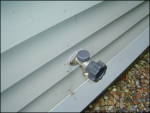What is the Purpose of the Anti-Siphon Valve on an Outdoor Faucet
By Mark J. Donovan
|
|
Question: Mark, I shut of the valve inside my home to the outdoor frost free hose bib, and I am wondering if I need to do anything else associated with the anti-siphon valve that sits on top of the hose bib. Also, what is the purpose of the anti-siphon valve? Any thoughts would be appreciated.
Answer: D.G., A frost free hose bib with an anti-siphon valve is pretty easy to operate and maintain. As you did, you just need to turn off the valve inside the home to the hose bib, and then temporarily turn the outdoor faucet valve on to drain any water out of the end of the hose bib pipe. |
After the water has dribbled out, close the outdoor faucet valve. Also, if you have a garden hose attached to the hose bib, make sure to remove it and store it away for the winter.
In regards to the anti-siphon valve, or atmospheric pressure valve, you should not have to do anything to it. If the frost free hose bib was installed properly the pipe should tilt slightly downwards so water automatically drains out of it when you turn on the outside faucet valve. The cap that sits on top of the frost free hose bib should be hand tight. The only purpose of the cap is to allow access to repairing the valve if in the event it ever fails. The anti-siphon valve effectively creates an air gap in the hose bib to protect a home’s water supply.
| More specifically the anti-siphon valve, or atmospheric pressure valve, on the hose bib prevents water that may be in a garden hose to not be siphoned, or drawn back, into the potable water supply within the home, in the event there is a negative pressure with the home’s water supply.
They are effectively designed to leak when a home’s water supply pressure is turned off to the outdoor faucet, e.g. by turning the outdoor faucet’s valve to the off position, or if the home’s water supply pressure becomes negative. |
 |
For example, if you had the far end of a garden hose lying in a pool and there was a sudden loss of pressure to the home’s water supply, the negative pressure created by the pool water could cause the pool water to enter your home’s potable water supply via the hose bib, if it were not for the anti-siphon valve.
This would be a potentially unhealthy situation if the water was in some way contaminated. The anti-siphon valve on the outdoor faucet prevents the water in the garden hose from back-flowing into the home by causing it to safely escape out the outdoor faucet itself.
For information on installing a shower pan membrane liner for a ceramic tile shower, see the Shower Pan Membrane Liner Installation eBook from HomeAdditionPlus.com. The Shower Pan Membrane Liner EBook will quickly teach you the step-by-step process for installing the shower pan membrane liner correctly. It includes instructions on framing the shower stall, pouring the pre-slope and shower base mortar, and installing the shower pan membrane liner.
For information on how to tile a custom ceramic tile shower, see the “How to Tile a Custom Ceramic Tile Shower eBook” from HomeAdditionPlus.com. This eBook will quickly provide you with step-by-step instructions on how to measure and install ceramic tile in a shower, including the installation of tile on shower walls, floors and curbs. It provides detailed instructions for every step in the process of tiling a custom ceramic tile shower and is loaded with instructional pictures!
Related Information
- How to Fix a Leaky Outdoor Sillcock Video
- How to Install a Frost Free Outdoor Faucet Sillcock
- How to Fix a Leaky Outdoor Faucet
Additional Plumbing Resources from Amazon.com
 |
 |
Get Free Bathroom Remodeling Price Quotes with No Obligation!
Fill out our 3-5 minute quick and easy form, and receive a free price quote on a bathroom remodeling project from one of our pre-screened and licensed bathroom remodeling contractors. This process is free and there is no obligation to continue once you receive your bathroom addition price estimate.
